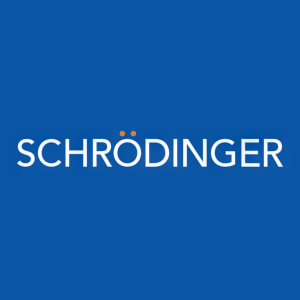Schrödinger Presents Data from Its MALT1 Inhibitor Program at the American Society of Hematology (ASH) 2020 Annual Meeting
Schrödinger, Inc. (Nasdaq: SDGR) presented promising preclinical data on its MALT1 inhibitor program targeting B-cell lymphomas at the 62nd ASH Annual Meeting. The newly identified MALT1 inhibitors demonstrated strong anti-tumor activity, both alone and in combination with existing therapies like ibrutinib and venetoclax. The company plans to advance this program into IND-enabling studies in the first half of 2021. This research showcases the potential for MALT1 inhibitors to offer alternative treatment options for patients resistant to standard therapies.
- Strong preclinical data showing anti-tumor activity of MALT1 inhibitors.
- MALT1 inhibitors are effective alone and in combination with existing therapies.
- Plans to advance the program into IND-enabling studies in 2021.
- None.
Insights
Analyzing...
NEW YORK--(BUSINESS WIRE)--Schrödinger, Inc. (Nasdaq: SDGR), whose physics-based software platform is transforming the way therapeutics and materials are discovered, presented preclinical data from its wholly-owned MALT1 inhibitor program in B-cell lymphomas at the virtual 62nd American Society of Hematology (ASH) Annual Meeting. MALT1, mucosa-associated lymphoid tissue lymphoma translocation protein 1, is considered a potential therapeutic target for several non-Hodgkin’s B-cell lymphomas as well as chronic lymphocytic leukemia (CLL). Schrödinger scientists have identified novel MALT1 inhibitors that have shown strong anti-tumor activity in preclinical models alone and in combination with ibrutinib, a Bruton’s tyrosine kinase (BTK) inhibitor, and venetoclax, a B-cell lymphoma 2 (BCL-2) inhibitor, two anti-cancer therapies used to treat certain B-cell lymphomas and CLL.
“We are pleased our MALT1 inhibitors indicate promising preclinical anti-cancer activity in diffuse large B-cell lymphomas, commonly called DLBCL, as a single agent or in combinations. Our data suggest our lead molecules may expand therapeutic options for lymphoma patients who need alternative therapeutic options after relapse or becoming resistant to existing agents,” said Karen Akinsanya, Ph.D., Executive Vice President, Chief Biomedical Scientist and Head of Discovery R&D at Schrödinger. “Our preclinical work is ongoing, and we plan to advance this program into IND-enabling studies in the first half of 2021.”
The discovery of lead molecules in Schrödinger’s MALT1 program was accelerated with the company’s differentiated, physics-based platform, which facilitates exploration of vast amounts of chemical space. Schrödinger’s free energy perturbation technology (FEP+) was used in combination with machine learning to prioritize billions of computer- and human-designed compounds to identify and optimize potent, selective inhibitors with favorable drug-like properties in under one year.
Additional Details About the Study
The presentation, “Identification of Potent Paracaspase MALT1 Inhibitors for Hematological Malignancies,” highlighted preclinical data with multiple lead molecules discovered by Schrödinger scientists. The company’s MALT1 compounds showed potent in vitro inhibition of MALT1 enzymatic activity, with high binding affinity to the protein. Strong in vivo anti-tumor activity was observed in mouse xenograft models of DLBCL. Additionally, strong in vivo anti-proliferative effects were reported in combination with ibrutinib and venetoclax in mouse models. Taken together, these data provide further rationale for developing MALT1 inhibitors as a potential therapeutic approach particularly in combination with existing therapies to potentially treat relapsed/refractory B-cell lymphoma and difficult to treat blood cancers such as DLBCL.
About Schrödinger
Schrödinger is transforming the way therapeutics and materials are discovered. Schrödinger has pioneered a physics-based software platform that enables discovery of high-quality, novel molecules for drug development and materials applications more rapidly and at lower cost compared to traditional methods. The software platform is used by biopharmaceutical and industrial companies, academic institutions, and government laboratories around the world. Schrödinger’s multidisciplinary drug discovery team also leverages its software platform to advance collaborative programs and its own pipeline of novel therapeutics to address unmet medical needs.
Founded in 1990, Schrödinger has over 400 employees and is engaged with customers and collaborators in more than 70 countries. To learn more, visit www.schrodinger.com and follow us on LinkedIn and Twitter.
Forward-Looking Statements
This press release contains forward-looking statements within the meaning of The Private Securities Litigation Reform Act of 1995 including, but not limited to those regarding the clinical potential and favorable properties of our MALT1 inhibitor program, the potential for MALT1 inhibitors to be used alone or in combination with BTK and BCL-2 inhibitors to treat B-cell malignancies, the timing of potential IND-enabling studies for our MALT1 program, and the potential of our platform to enable the discovery of high-quality, novel molecules for drug development and materials applications. Statements including words such as "anticipate," "believe," "contemplate," "continue," "could," "estimate," "expect," "intend," "look forward," "may," "might," "plan," "potential," "predict," "project," "should," "target," "will," "would" and statements in the future tense are forward-looking statements. These forward-looking statements reflect our current views about our plans, intentions, expectations, strategies and prospects, which are based on the information currently available to us and on assumptions we have made. Actual results may differ materially from those described in these forward-looking statements and are subject to a variety of assumptions, uncertainties, risks and factors that are beyond our control, including the uncertainties inherent in early stage drug development, including the conduct of research activities, the initiation and completion of preclinical studies and clinical trials; uncertainties as to the availability and timing of results from preclinical studies; the timing of and our ability to submit and obtain regulatory approval for investigational new drug applications; whether results from preclinical studies will be predictive of the results of later preclinical studies and clinical trials, as well as the other risks and uncertainties identified under the caption "Risk Factors" and elsewhere in our Securities and Exchange Commission filings and reports, including the Quarterly Report on Form 10-Q filed with the Securities and Exchange Commission on November 12, 2020, as well as future filings and reports by us. Any forward-looking statements contained in this press release speak only as of the date hereof. Except as required by law, we undertake no duty or obligation to update any forward-looking statements contained in this press release as a result of new information, future events, changes in expectations or otherwise.







